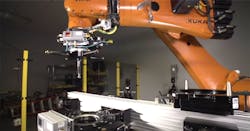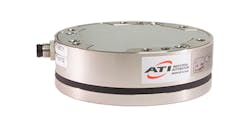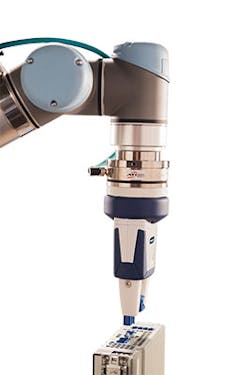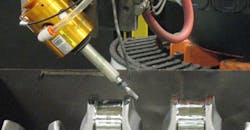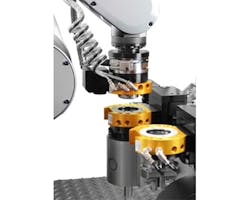The 1980s began with General Motors chairman Roger B. Smith predicting robots would replace humans as wages rose. A dollar an hour hike would lead to a thousand more robots on the factory floor. Reality proved his math was off, and by the end of the decade, robot sales were in decline.
"There was stagnation, and robots weren't selling in the way everybody thought they would," recalls Robert Little, CEO of ATI Industrial Automation.
It's not that the idea of robots was flawed, as they could weld and handle heavy materials, but something was missing: versatility. Humans could learn to do pretty much whatever is asked of them, while robots were fixed, hardwired, inflexible, and due to limited choices for end effectors, severely lacking in dexterity, an area in which people excel. Often powered by hydraulics, the robots had a gorilla-like grip.
That's why Little, along with fellow engineers Keith Morris and Dwayne Perry founded ATI in 1989.
"We had a mission to develop end effectors that could survive the harsh treatment robots give them," says Little, who started as ATI's COO. "We built ourselves on engineering bullet-proof end effectors, and it worked. The quality went up, and our sales started to rise. It made robots easier to use and increased robot sales in general."
New robot installations in America did steadily increase in the early 90s, nearly doubling from 1993 to 1995, when the market first crossed the 10,000 unit threshold. How much of that can be attributed to end effectors is debatable, but what's not is that the robot attachments grew in quality and capability. Grippers, now powered by pneumatics, picked up parts with greater precision. Tool changers allowed robots to seamlessly transition from a welding end effector to a machining spindle in moments.
ATI's MC-10 Manual Tool Changer easily twists on, with fail-safes to reduce vibrations and prevent loosening.
Adding force-torque sensors leads to better feedback, further refined accuracy, and repeatability. Interestingly, six-axis force/torque sensors were used as far back as 1973 at NASA's Jet Propulsion Laboratory, as this excerpt from a JPL research paper shows:
The drive motor torque required to achieve the link angle/time function is then computed based on a model of the manipulator hardware. The motor voltage/torque characteristic is also modeled, and the computed torque is converted to applied motor voltage. This voltage is computed at a very high rate, applied to D/A converter, and finally to the motor input.
ATI, now a global leader in six-axis F/T sensors, has improved exponentially upon the initial concept, culminating in the Axia80. The high powered, compact attachment couples to the robot arm and can fit a number of end effectors to increase dexterity. Whereas traditional robots are seen as mechanical and rigid, attaching an Axia80 enables acute responsiveness that is ideal for high precision operations.
This makes them the perfect accessory for collaborative robots. The Axia80 works with leading cobot manufacturer Universal Robots' UR-3, 5, and 10.
Cobots, such as the new E-series UR models, do include F/T sensors already, but the Axia80 sensor is up to five times more accurate, with as much as twenty times the resolution.
“It's always good to ensure you have the best force sensor available," Little explains. "The Axia80 detects something as simple as a finger caught underneath a part." Although a human hand may cause a tiny amount of deflection, the Axia80 can sense these minimal variations and signal the robot to react.
Keeping all workers safe is a top priority of any automated cobot system, with improved quality close behind. F/T sensors are able to improve safety and process flexibility simultaneously. Better sensing makes way for a wider variety of applications; which is excellent for those who invest in robotics. As technology keeps moving forward, there will be more and more opportunities for robots and humans to work together safely and efficiently.
Unlike the envisioned of GM's chairman, the jobs these robots take are not the ones people will miss. A worker would be much better suited to managing several machines and talking to current or prospective customers rather than shaving and polishing a metal widget.
In today’s machine shop, the tool changer transforms one robot into a multi-tasking machine. It can use parallel grippers to pick up a part and place it in a milling machine, which does the heavy material removal. Then, the tool changer can switch to a robotic deburrer to finish the part. Laborers, previously tending machines, become programmers and develop new skill sets to advance their careers.
"Robots always succeed in doing work people don't want to do," Little says.
Decommissioning nuclear power plants would be considered a less-than-ideal job for people, so ATI designed tool changers that can withstand gamma radiation by fortifying the electronics shielding.
"We're not just selling an end effector," Little says. "We're selling a solution, which means we have to grasp - literally and figuratively, everything within the application to ensure success.
ATI will be at IMTS 2018 in Chicago, in Booth #236417, where it will show off cobot applications in an open environment, along with enclosed demos of high-speed applications and material removal.
About the Author
John Hitch
Editor, Fleet Maintenance
John Hitch, based out of Cleveland, Ohio, is the editor of Fleet Maintenance, a B2B magazine that addresses the service needs for all commercial vehicle makes and models (Classes 1-8), ranging from shop management strategies to the latest tools to enhance uptime.
He previously wrote about equipment and fleet operations and management for FleetOwner, and prior to that, manufacturing and advanced technology for IndustryWeek and New Equipment Digest. He is an award-winning journalist and former sonar technician aboard a nuclear-powered submarine where he served honorably aboard the fast-attack submarine USS Oklahoma City (SSN-723).
